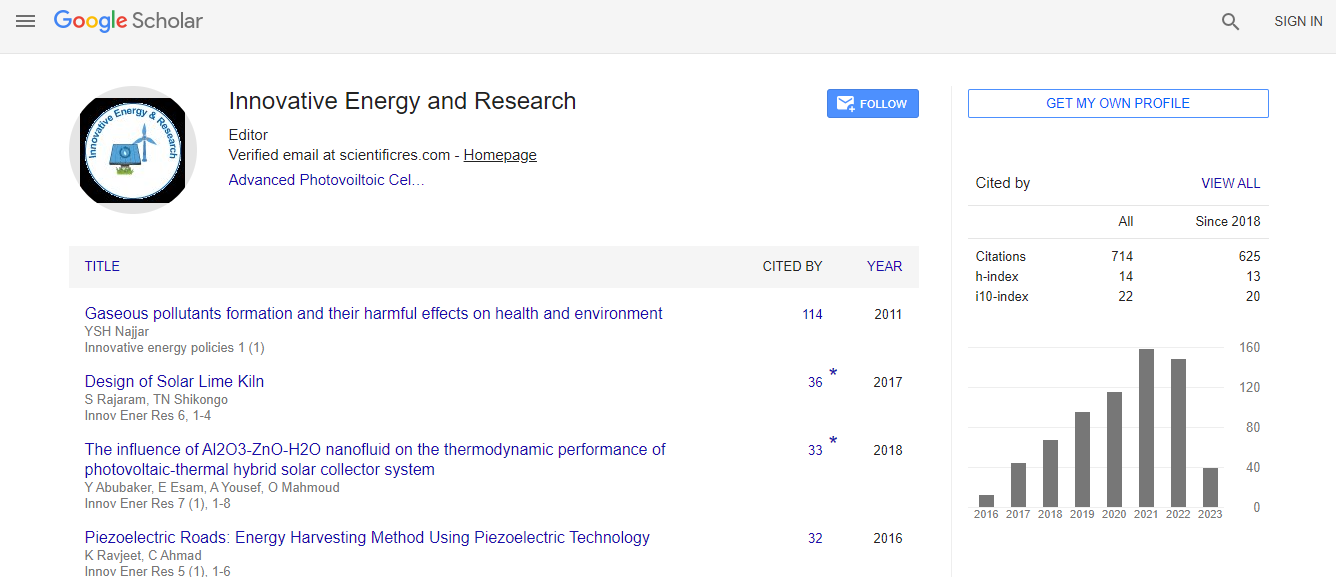Our Group organises 3000+ Global Conferenceseries Events every year across USA, Europe & Asia with support from 1000 more scientific Societies and Publishes 700+ Open Access Journals which contains over 50000 eminent personalities, reputed scientists as editorial board members.
Open Access Journals gaining more Readers and Citations
700 Journals and 15,000,000 Readers Each Journal is getting 25,000+ Readers
Google Scholar citation report
Citations : 712
Innovative Energy & Research received 712 citations as per Google Scholar report
Innovative Energy & Research peer review process verified at publons
Indexed In
- Google Scholar
- Open J Gate
- Genamics JournalSeek
- RefSeek
- Hamdard University
- EBSCO A-Z
- Publons
- Euro Pub
- ICMJE
Useful Links
Recommended Journals
Related Subjects
Share This Page
Photoelectrochemical materials for sunlight-driven water splitting devices
Joint Event on 2nd International Conference on Renewable Energy and Resources & Energy Materials and Fuel Cell Research
Hiroshi Nishiyama
The University of Tokyo, Japan
Posters & Accepted Abstracts: Innov Ener Res
Abstract
Photocatalysis or photoelectrochemistry are attractive developing fields of engineering for building free-running sunlightdriven water splitting to generate H2 and O2. We are surveying solar-spectrum-responding semiconductive materials as the candidates for the visible light absorbers in the H2+O2 harvesting devices. We have been fabricating and testing water photo-splitting devices composed of a pair of photocathode (p-type, for H2) and photoanode (n-type, for O2) both decorated with catalysts for evolving those gases. As for photocathode, we developed H2 evolving flat layered sheets based on chalcopyrite Cu(In, Ga)Se2 (CIGS, the cutoff wavelength of absorption ~ 1100 nm) and its doped versions with Zn, S, etc. The photocurrent obtained by the solar simulator (AM 1.5G) can afford more than 10% of solar hydrogen conversion efficiency. The photoanode material is the remaining problem to solve. BiVO4 (~540 nm), paired with CIGS, realized a stable operation for the stoichiometric faradaic evolution of H2 and O2, however, the maximum solar-to-H2 efficiency has been below 4 %. Obviously, we need n-type light absorbers with longer cutoff wavelength. We are also developing transition metal nitrides and oxynitrides for the sunlight absorbers. Ta3N5 (~600 nm) has been the most intensively investigated, as particles embedded on metal layers (particle transferred sheets) and flat layered thin films, both of which can serve as photoanodes. Foreign materials can be assembled as the background layer or capping layer for the Ta3N5 layer to improve the electronic properties and robustness as an electrode immersed in the electrolytic solution. We will discuss the best performance for Ta3N5 and oxynitrides as O2-evolving photoelectrodes energized by solar irradiation.Biography
Hiroshi Nishiyama completed his Ph.D. at Nagaoka University of Technology, Japan in 2005. In 1998–2013, he was an assistant professor at the Analysis and Instrumentation Center at Nagaoka University of Technology. He is currently a principal project researcher in the R&D Laboratory of Artificial Photosynthetic Chemical Process (ARPChem) at The University of Tokyo. His research focuses on the development of high-performance photoanode electrodes and high-performance PEC systems.
E-mail: nishiyama@arpchem.t.u-tokyo.ac.jp

 Spanish
Spanish  Chinese
Chinese  Russian
Russian  German
German  French
French  Japanese
Japanese  Portuguese
Portuguese  Hindi
Hindi 
